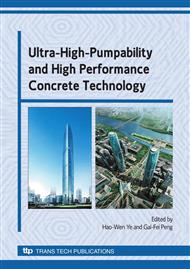[1]
T. Sugiyama, T.W. Bremmer. Effects of stress on gas permeability[J]. ACI Materials Journal, No. 93, (1994), pp.443-450.
Google Scholar
[2]
B. Gerard, J. Marchand. Influence of cracking on the diffusion properties of cement -based materials PartI: Influence of continuous cracks on the steady-state regime[J]. Cement and Concrete Research, No. 30, (2000), pp.37-43.
DOI: 10.1016/s0008-8846(99)00201-x
Google Scholar
[3]
Li Jinyu, Peng Xiaoping, et al. Study on low-exothermic and high crack-resisting dam concrete with HBC [J]. Water Power (China), No. 3, (2003), pp.58-62.
Google Scholar
[4]
P. K. Mehta, R. W. Burrows. Building durable structures in the 21st century[J]. The Indian Concrete Journal, (2001), pp.437-443.
Google Scholar
[5]
R.W. Burrows, W.F. Kepler, D. Hurcomb, J. Schaffer, J.G. Sellers. Three simple tests for selecting low-crack cement[J]. Cement & Concrete Composites, No. 26, (2004), pp.509-519.
DOI: 10.1016/s0958-9465(03)00066-0
Google Scholar
[6]
Aitcin P. C. Cements of yesterday and today. Concrete of tomorrow [J]. Cement and Concrete Research, No. 30, (2000), pp.1349-1359.
DOI: 10.1016/s0008-8846(00)00365-3
Google Scholar
[7]
Neville A. Why we have concrete durability problems[R]. ACI SP 100-3, (1987), pp.21-30.
Google Scholar
[8]
Brewer, H.W. and Burrows, R.W., Coarse Ground Cement Makes More Durable Concrete [J], ACI Journal, No. 47, (1951), pp.353-360.
DOI: 10.14359/11997
Google Scholar
[9]
Lian Huizhen, Liang Wenquan Connection between cement character and concrete quality(2).
Google Scholar
[10]
R.W. Burrows. The visible and invisible cracking of concrete [M], ACI Monograph No. 11, Published by ACI, Farmington Hills, Michigan, FirstEdition, (1998).
Google Scholar
[11]
Gao Peiwei, Wu Shengxing, et al. Influence on the volume stability of cementitious materials on the cracking of dam concrete [J]. Water Power (China), Vol. 31, No. 3, (2005), pp.33-36.
Google Scholar
[12]
Lian Huizhen, Liang Wenquan Connection between cement character and concrete quality(1).
Google Scholar
[13]
Sun Zhenping, Jiang Zhengwu, et al. Compatibility between Concrete Admixtures and Cement [J]. Journal of Building Materials (China), Vol. 5, No. 1, (2002), pp.26-31.
Google Scholar
[14]
Wu ZhongWei, Lian MuZhen. High performance concrete [M]. Published by China railway publishing house, Beijing, China, (1999).
Google Scholar
[15]
Qian XiaoQian, Zhan ShuLin, et al. Effects of admixtures and SRA on early age shrinkage of concrete [J]. Journal of Shenyang Jianzhu University (Natural Science Edition) (China), Vol. 21, No. 6, (2005), pp.692-696.
Google Scholar
[16]
Wang XueFang, Zheng JianLan, et al. Influence of fly ash on early - age crack of high - flowing concrete [J]. Journal of Fuzhou University (Natural Science Edition) (China), Vol. 33, Supp. 1 (2005), pp.156-161.
Google Scholar
[17]
Zhang ShuQing, Cai JiMin, et al. The resistance to cracking of concrete with additive at early age [J]. Fly Ash Comprehensive Utilization (China), No. 6, (2003), pp.10-12.
Google Scholar
[18]
Li PingJiang, Shi GuanLun, et al. Relation between fineness and pozzolanic activity of fly ash [J]. Journal of Building Materials (China), Vol. 7, No. 2, (2004), pp.207-209.
Google Scholar
[19]
Huang ZhaoLong, Zhan YuanYuan. The influence of the fly-ash burning-loss amount and materials mix proportion to concrete engineering property [J]. Fly Ash Comprehensive Utilization (China), No. 1, (2003), pp.9-13.
Google Scholar
[20]
Hou XinKai, Xu DeLong, et al. A study on the activity and fluidity of GGBS [J]. Journal of Xi'an University of Architecture & Technology (China), Vol. 36, No. 3, (2004), pp.263-269.
Google Scholar
[21]
Weng YouFa, Zhang Dong. Effect of fineness of slag on property of high strength concrete.
Google Scholar
[22]
OuYang HuaLin, Su ZhuPing, et al. Test Study of High Performance Concrete Added with Considerable Amount of Ground Slag Powder [J]. World Bridges (China), No. 1, (2006), pp.56-58.
Google Scholar
[23]
Zhang YaJie, Zhang PingJun. Study on effect of micro-slag on the stability of concrete physical volume [J]. Fly Ash Comprehensive Utilization (China), No. 2, (2005), pp.26-27.
Google Scholar
[24]
Niu JinQuan, Feng NaiQian, et al. Mechanism of superfine slag powder [J]. Journal of Building Materials (China), Vol. 5, No. 1, (2002), pp.84-89.
Google Scholar
[25]
Wang JianFu, Yang QuanBing. Effect of slag on resistance to cracking of concrete at early age [J]. China Concrete and Cement Products, No. 1, (2006), pp.10-14.
Google Scholar
[26]
Liang WenQuan, Wang XinGang, et al. Influence of GGBFS content on shrinkage cracking of concrete [J]. Engineering Journal of Wuhan University (China), Vol. 37, No. 1, (2004), pp.77-81.
Google Scholar
[27]
Wang YuLi, Guan XueMao, et al. Influence of grain gradation of coarse aggregates on concrete strength [J]. Journal of Henan Polytechnic University(Natural Science) (China), Vol. 23. No. 3, (2004), pp.213-215.
Google Scholar
[28]
Xu JinJun, An ZhiWen, et al. Countermeasure of temperature crack of mass concrete [J]. Journal of Hebie Institute of Architectural Engineering (China), Vol. 23, No. 3, (2005), P. 36-40.
Google Scholar
[29]
Zhang Tie, Lu AnQi. Optimization research on mix proportion for high strength mass concrete [J]. Design of Hydroelectric Power Station (China), Vol. 13, No. 1, (1997), pp.10-16.
Google Scholar
[30]
Attiogbe E K. Mean spacing of air void in hardened concrete [J]. ACI Materials Journal, 1993, 90(2): 174-181.
Google Scholar
[31]
Feng NaiQian, Xing Feng, et al. The experiments and applications of the aminosulfonic acid high range water-reducing agent [J]. Concrete (China), No. 9, (2002), pp.28-57.
Google Scholar
[32]
Wang Ying, Guo YanHui. Crack control of concrete and selection of admixture in Shenzhen.
Google Scholar


